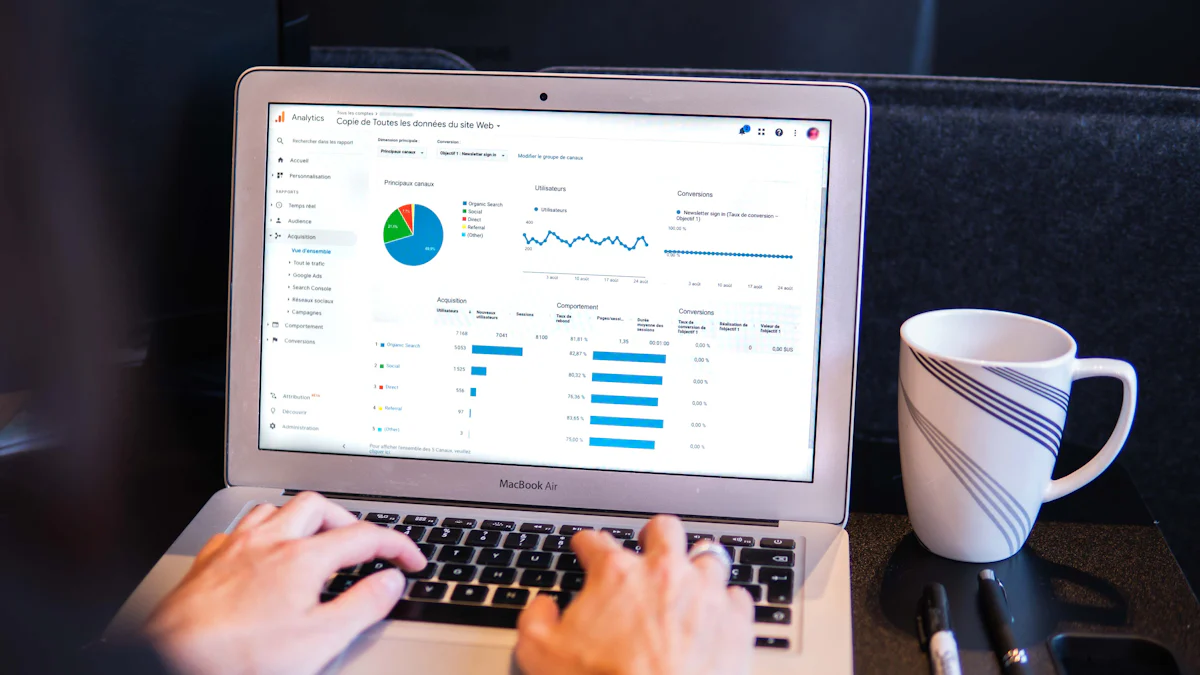


Self Service Analytics empowers you to explore data independently. In today's fast-paced business world, this capability is crucial. You can make quicker decisions by analyzing real-time data without waiting for IT support. This approach boosts productivity and encourages collaboration across departments. As more organizations adopt these tools, they see higher rates of business intelligence usage. By enabling you to create reports and dashboards on your own, Self Service Analytics fosters a data-driven culture that aligns with modern business needs.
Understanding Self-Service Analytics
Definition and Key Concepts of Self-Service Analytics
What is Self-Service Analytics?
Self Service Analytics empowers you to access and analyze data without needing constant IT support. This approach allows you to explore data independently, leading to faster insights and more informed decisions. By decentralizing data access, Self Service Analytics democratizes information within your organization. You can actively participate in reporting and analysis, breaking down traditional silos that often hinder collaboration.
Core Components
The core components of Self Service Analytics include user-friendly interfaces, intuitive data visualization tools, and robust data integration capabilities. These elements enable you to manipulate and visualize data effectively. With these tools, you can create reports and dashboards that provide valuable insights into your business operations. The accessibility of these components ensures that even non-technical users can engage with data, fostering a data-driven culture across your organization.
Historical Context of Self-Service Analytics
Evolution of Data Analytics
Data analytics has evolved significantly over the years. Initially, only IT departments and data specialists could handle complex data queries and generate reports. This centralized approach often led to delays and bottlenecks. As businesses recognized the need for quicker decision-making, the demand for more accessible analytics solutions grew. Self Service Analytics emerged as a response to this need, allowing you to access data directly and make timely decisions.
Rise of Self-Service Solutions
The rise of Self Service Analytics solutions marked a significant shift in how organizations handle data. These solutions empower you to generate reports and insights without waiting for IT assistance. By putting the power of data analysis in your hands, Self Service Analytics tools have paved the way for broader business intelligence adoption. As a result, you can integrate data into your daily operations, enhancing productivity and strategic decision-making.
Benefits of Self-Service Analytics

Empowering Users of Self-Service Analytics
Democratization of Data
Self Service Analytics plays a pivotal role in democratizing data within organizations. You gain the ability to access and analyze data without needing specialized IT skills. This empowerment allows you to participate actively in strategic initiatives. By decentralizing data access, Self Service Analytics breaks down barriers, enabling everyone in your organization to contribute to data-driven decisions. This approach fosters a culture where data is not confined to a select few but is available to all, enhancing collaboration and innovation.
Enhanced Decision-Making
With Self Service Analytics, you can make faster and more informed decisions. Access to real-time data means you no longer have to wait for IT departments to generate reports. You can quickly analyze relevant data, leading to better collaboration across departments. This capability boosts productivity and ensures that decision-making processes are based on the most current information. By integrating data into your daily operations, you enhance your ability to respond swiftly to changing business environments.
Operational Efficiency of Self-Service Analytics
Time Savings
Self Service Analytics significantly reduces the time spent on data analysis. You can generate reports and insights independently, eliminating the need to rely on IT support. This autonomy allows you to focus on core business activities rather than waiting for data processing. The time saved can be redirected towards strategic planning and execution, enhancing overall operational efficiency. By streamlining data access, Self Service Analytics ensures that you can act promptly on insights, driving business growth.
Cost Reduction
Implementing Self Service Analytics can lead to substantial cost savings. By reducing the dependency on IT resources for data analysis, you lower operational costs. The ability to create ad hoc reports without external assistance minimizes the need for additional staffing or outsourcing. Furthermore, the increased efficiency and productivity resulting from quicker decision-making contribute to cost-effectiveness. Self Service Analytics enables you to optimize resource allocation, ensuring that your organization operates within budget while maximizing output.
Challenges in Implementing Self-Service Analytics
Implementing Self Service Analytics can transform your organization, but it comes with its own set of challenges. Understanding these challenges helps you navigate the implementation process more effectively.
Data Governance
Ensuring Data Quality
Data quality is crucial for effective Self Service Analytics. You must ensure that the data you use is accurate and reliable. Without proper data governance, you risk making decisions based on flawed information. Establishing a robust data governance framework helps maintain data integrity. This framework should control data access at various levels, ensuring that only authorized users can modify or view sensitive information. By doing so, you create a homogenous pool of enterprise-level data that everyone can trust.
Security Concerns
Security remains a top priority when implementing Self Service Analytics. You need to enforce strict data governance rules to protect sensitive information. Unauthorized access can lead to data breaches, compromising your organization's security. Implementing security measures, such as encryption and access controls, helps mitigate these risks. Regular audits and monitoring also ensure that your data remains secure. By prioritizing security, you safeguard your organization's valuable data assets.
User Adoption
Training and Support
For Self Service Analytics to succeed, you must focus on user adoption. Providing adequate training and support is essential. Users need to understand how to utilize the tools effectively. Without proper guidance, they may struggle to adopt the new system. Offering comprehensive training sessions and ongoing support helps users become comfortable with the technology. This approach empowers them to create data projects independently, reducing reliance on IT departments.
Resistance to Change
Resistance to change is a common challenge in implementing Self Service Analytics. Some users may hesitate to adopt new technologies, preferring traditional methods. To overcome this resistance, you should communicate the benefits of Self Service Analytics clearly. Highlight how it enhances productivity and decision-making. Encouraging a culture of innovation and collaboration also helps ease the transition. By addressing concerns and providing incentives, you can foster a positive attitude towards change.
Tools and Platforms for Self-Service Analytics
Popular Tools
FineBI
FineBI stands out as a leading tool in the realm of self-service analytics. It offers user-friendly interfaces that allow you to create interactive data visualizations effortlessly. With FineBI, you can transform complex data sets into intuitive dashboards and reports. This tool democratizes data access, enabling you to explore and analyze information without needing extensive technical skills. Its widespread adoption highlights its effectiveness in promoting data democracy within organizations.
Power BI
Power BI is another powerful tool that facilitates self-service analytics. Developed by Microsoft, it integrates seamlessly with other Microsoft products, making it a popular choice for businesses already using tools like Excel. Power BI empowers you to access and analyze data in real-time, providing insights that drive informed decision-making. Its ability to handle large data sets and generate comprehensive reports makes it an invaluable asset for business professionals and data analysts alike.
Choosing the Right Platform
Factors to Consider
When selecting a self-service analytics platform, consider several key factors. First, evaluate the ease of use. A platform with an intuitive interface will enable you to navigate and utilize its features effectively. Next, assess the integration capabilities. Ensure that the platform can seamlessly connect with your existing data sources and tools. Additionally, consider the level of support and training available. Adequate resources will help you maximize the platform's potential.
Customization and Scalability
Customization and scalability are crucial when choosing a self-service analytics platform. You need a solution that can adapt to your organization's unique needs. Look for platforms that offer customizable dashboards and reports, allowing you to tailor the analytics experience to your specific requirements. Scalability is equally important. As your organization grows, the platform should be able to handle increased data volumes and user demands without compromising performance.
Best Practices for Implementation of Self-Service Analytics
Implementing Self Service Analytics effectively requires careful planning and continuous improvement. By following best practices, you can maximize the benefits and ensure a smooth transition for your organization.
Strategic Planning
Setting Clear Objectives
To begin with, you must set clear objectives for your Self Service Analytics initiative. Define what you aim to achieve with this implementation. Whether it's improving decision-making speed or enhancing data accessibility, having specific goals will guide your efforts. Clear objectives help you measure success and make necessary adjustments along the way.
Aligning with Business Goals
Aligning Self Service Analytics with your business goals is crucial. Ensure that the analytics tools and processes support your organization's strategic direction. This alignment ensures that data-driven insights contribute to achieving broader business objectives. When analytics initiatives align with business goals, they become integral to your organization's success.
Continuous Improvement
Feedback Loops
Establishing feedback loops is essential for continuous improvement in Self Service Analytics. Encourage users to provide feedback on their experiences with the tools and processes. Regularly review this feedback to identify areas for enhancement. By incorporating user input, you can refine the analytics environment and address any challenges that arise.
Iterative Development
Adopt an iterative development approach for your Self Service Analytics implementation. Start with a basic setup and gradually expand its capabilities. This method allows you to test and refine features based on user needs and feedback. Iterative development ensures that the analytics system evolves to meet changing requirements, providing ongoing value to your organization.
Self Service Analytics empowers you to explore and analyze data independently. By setting clear objectives and aligning with business goals, you can harness its full potential. Continuous improvement through feedback loops and iterative development ensures that your analytics environment remains effective and relevant. Embrace these best practices to create a data-driven culture that supports informed decision-making and organizational growth.
Real-World Applications of Self-Service Analytics

Self Service Analytics transforms how industries operate by enabling data-driven decisions. Let's explore how different sectors utilize these tools to enhance efficiency and innovation. Self Service Analytics
Industry Use Cases
Healthcare
In healthcare, Self Service Analytics empowers you to improve patient care and operational efficiency. By analyzing patient data, you can identify trends and predict outcomes. Hospitals use these insights to optimize resource allocation and reduce wait times. For example, analyzing patient flow data helps in scheduling staff more effectively, ensuring that patients receive timely care.
Retail
Retailers leverage Self Service Analytics to understand customer behavior and preferences. You can analyze sales data to identify popular products and adjust inventory accordingly. This approach helps in personalizing marketing strategies, enhancing customer satisfaction. By examining purchasing patterns, retailers can also optimize pricing strategies, leading to increased sales and customer loyalty.
Success Stories
Netflix
Netflix uses Self Service Analytics to personalize content recommendations. By analyzing viewing habits, you can tailor suggestions to individual preferences. This personalization enhances user experience and keeps subscribers engaged. Netflix's ability to predict what viewers want to watch next demonstrates the power of data-driven decision-making.
Amazon
Amazon employs Self Service Analytics to streamline its supply chain and improve customer service. By analyzing purchasing data, you can forecast demand and manage inventory efficiently. This capability ensures that products are available when customers need them, reducing delivery times. Amazon's success in using data to enhance operations highlights the importance of integrating analytics into everyday workflows.
Self Service Analytics empowers you to harness data effectively across various industries. By adopting these tools, you can drive innovation and improve decision-making. Whether in healthcare or retail, the ability to analyze and act on data leads to better outcomes and a competitive edge.
Future Trends in Self-Service Analytics
Technological Advancements
AI and Machine Learning Integration
AI and machine learning are transforming self-service analytics. You can now leverage these technologies to gain deeper insights. AI helps automate data analysis, making it faster and more accurate. Machine learning models can predict trends and patterns, allowing you to make proactive decisions. This integration enhances your ability to understand complex data without needing extensive technical skills.
Predictive Analytics
Predictive analytics is becoming a key feature in self-service tools. You can use it to forecast future outcomes based on historical data. This capability enables you to anticipate market trends and customer behavior. By using predictive models, you can make informed decisions that align with your strategic goals. This approach not only improves efficiency but also gives you a competitive edge.
Evolving User Expectations
Increased Personalization
Users now expect personalized experiences in analytics. You want tools that cater to your specific needs and preferences. Self-service platforms are evolving to offer customizable dashboards and reports. This personalization allows you to focus on the data that matters most to you. By tailoring analytics to individual users, organizations can enhance engagement and satisfaction.
Greater Accessibility
Modern platforms offer mobile compatibility and intuitive interfaces. This accessibility ensures that you can analyze data on the go, making timely decisions possible.
Self-service analytics empowers you to access and analyze data independently, leading to faster insights and better decisions. This capability is crucial for driving efficient decision-making and achieving better outcomes. By democratizing data access, self-service analytics enables you to explore data sets, create custom reports, and make informed decisions quickly. Its ongoing importance cannot be overstated. As you explore and implement these tools, you foster a data-driven culture that aligns with modern business needs. Embrace self-service analytics to enhance productivity and innovation within your organization.
FAQ
Self-service analytics allows you to access and analyze data without needing constant IT support. You can create reports and dashboards independently, which empowers you to make informed decisions quickly.
It enables you to integrate data into your daily operations, boosting productivity and collaboration. By reducing reliance on IT departments, you can focus on strategic initiatives and adapt swiftly to changing business environments.
Non-technical users can participate in business intelligence (BI) initiatives without needing specialized skills. This democratization of data fosters a culture where everyone can contribute to data-driven decisions.
You may encounter challenges such as ensuring data quality and security. Additionally, aligning data creators with data self-servers is crucial to avoid wasted opportunities. Providing adequate training and support can also help overcome resistance to change.
Tools like FineBI and Power BI are popular choices. They offer user-friendly interfaces and robust data visualization capabilities, allowing you to explore and analyze data effectively.
Set clear objectives and align them with your business goals. Encourage continuous improvement through feedback loops and iterative development. This approach ensures that your analytics environment remains effective and relevant.
Continue Reading About Self-Service Analytics
Augmented Analytics: Unlock the Core Concepts & Benefits!
Discover augmented analytics—where AI and ML automate data prep and insights, revolutionizing decision-making for smarter, faster business strategies!
Lewis
Mar 04, 2025
Which Data Analysis Projects Work Best for Beginners?
Ready to shine in 2025? Discover easy data analysis projects to boost your portfolio, learn data cleaning, visualization, and tackle real-world challenges!
Lewis
Mar 10, 2025
Business Data Analyst vs Business Analyst Key Differences Explained
Compare business data analyst vs business analyst roles, focusing on key differences, responsibilities, skills, and career paths to guide your career choice.
Lewis
Mar 11, 2025
Data Analysis vs Data Analytics: What’s the Real Difference?
Data Analysis vs Data Analytics: What’s the Difference? Discover How One Interprets History While the Other Shapes Tomorrow. Explore Here!
Lewis
Mar 10, 2025
Enhancing Analysis with Effective Data Cleaning Techniques
Master data cleaning techniques to enhance analysis accuracy and decision-making. Learn practical steps, tools, and real-life applications for clean data.
Howard
Oct 29, 2024
How to Craft an Effective Analytics Dashboard
Craft an effective analytics dashboard to track metrics and optimize business processes with actionable insights.
Lewis
Nov 15, 2024


